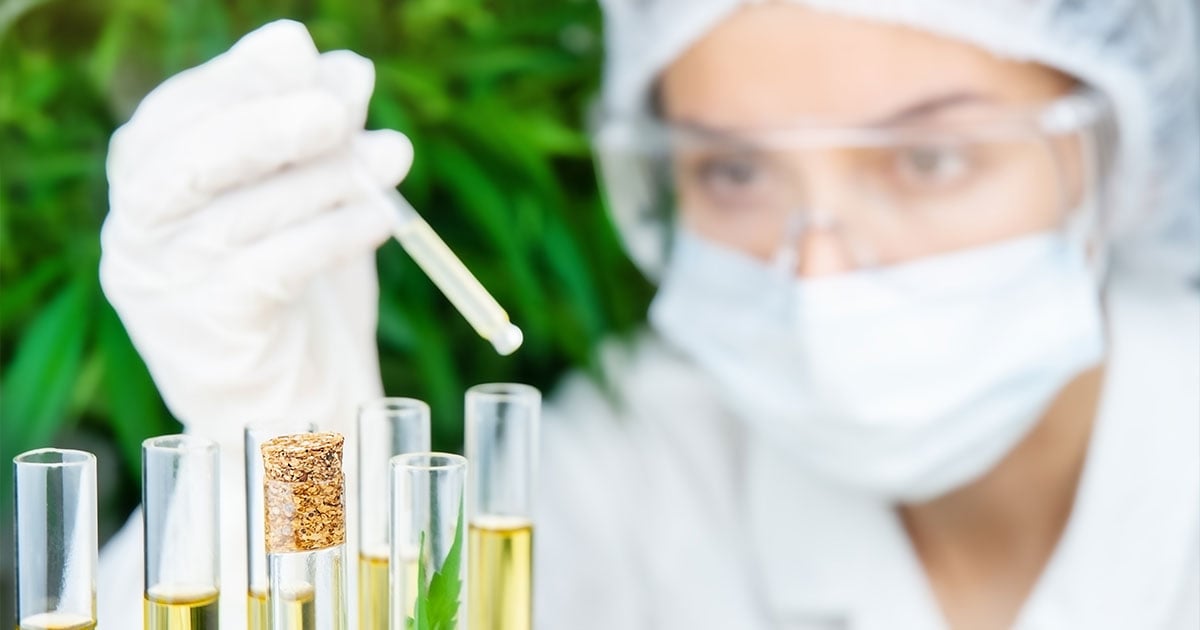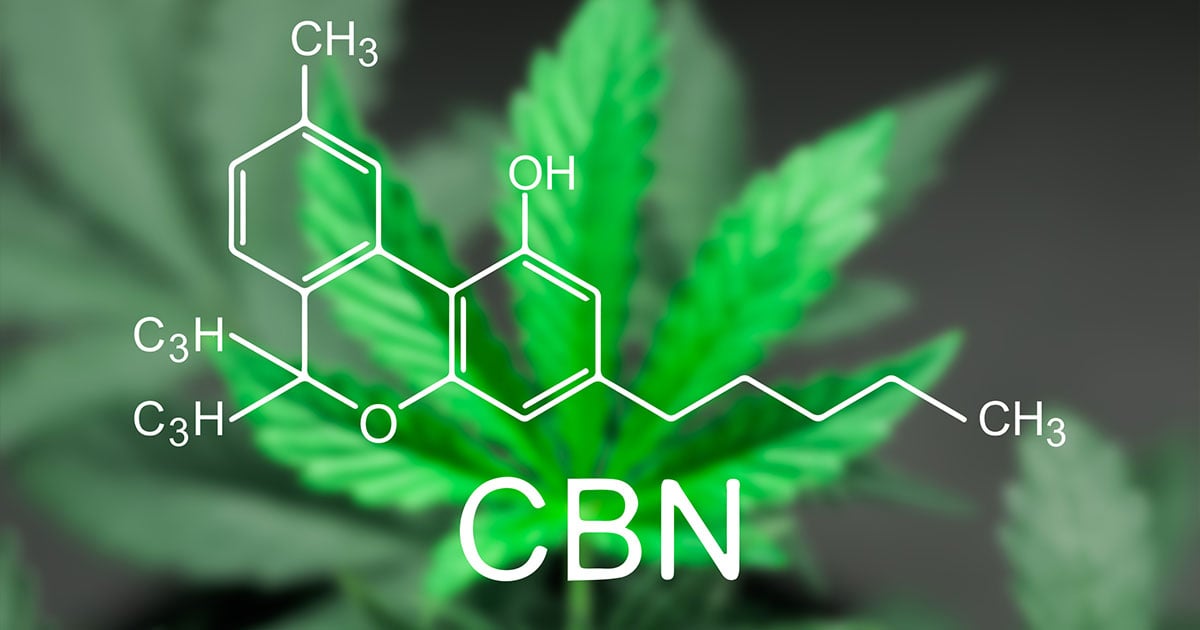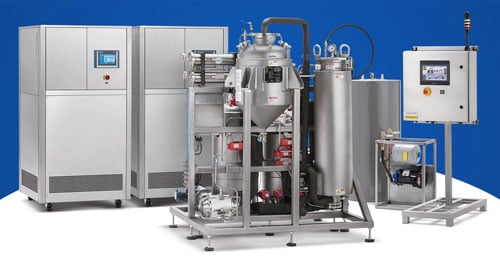
Cannabinol (CBN) is a minor cannabinoid with significant therapeutic potential. However, only trace amounts of CBN are found in cannabis plants. Complex extraction methods using chemical solvents must be used to remove a high concentration of CBN from the plant material.
Our comprehensive guide covers the essentials of the CBN extraction process, the industrial-grade equipment needed, and why cannabis processors are getting on the CBN bandwagon.
What Is Cannabinol (CBN)?

Cannabis contains over 400 chemical components, more than 100 of them cannabinoids. Cannabidiol (CBD) and delta-9 tetrahydrocannabinol (THC) are the most commonly found and well-researched cannabinoids. CBN is naturally found in under 1% of fresh plants.
Even though it is a byproduct of THC, CBN is not comparable to THC in terms of psychoactivity. CBN does not have intoxicating effects. CBN is created by exposure to heat, light, and air. Over time, the cannabis plant ages and converts THCA into CBNA. THCA is the acidic precursor to THC.
CBN’s health benefits are slowly being uncovered. There is limited scientific literature on CBN’s effects on humans. Still, preliminary studies suggest this minor cannabinoid has anti-inflammatory, sedative, anti-cancer, anticonvulsant, appetite-stimulating, and anti-allergic properties that may improve a person's quality of life.
What Is CBN Oil?
CBN oil products are still relatively rare compared to THC and CBD-rich products. Still, cannabis processors are increasingly creating a wide range of CBN products, including tinctures, gummies, isolates, vape cartridges, and capsules, among others. All of these products are formulated using CBN oil as a foundation.
CBN oil can refer to the unrefined crude oil made using extraction and purification steps. CBN oil can also refer to the final extract product, such as tinctures. Tinctures contain concentrated cannabis oil and carrier oil. Tinctures can be added to food or drinks or taken under the tongue (sublingually).
Can CBN Oil Get You High?
No, on its own, it is not intoxicating. As THCA ages and is exposed to heat, light, and oxygen, it converts to CBNA, reducing the overall potency of the flower. When CBN is paired with THC, it can increase THC’s potency.
CBN vs. CBD: What Is the Difference?
Consumers may get CBN and CBD mixed up due to their similar acronyms. However, there are a few key differences between these two cannabinoids.
Is CBN Oil Extraction Legal?
CBN oil’s legality falls in a legal gray area, depending on various factors. CBN is not explicitly listed as a scheduled controlled substance in the U.S. but may be considered a precursor to THC.
THC is a Schedule I substance, the same category as heroin and LSD. Schedule I substances are considered to have no medicinal value and a high risk for abuse. THC is federally legal in hemp products containing less than 0.3% THC. Here at Luna Technologies, we firmly support federal cannabis legalization, not criminalization.
The 2018 Farm Bill legalized hemp production and its derivative products (edibles, topicals, vape carts, etc.), making CBN oil derived from hemp federally legal. CBN oil derived from high-THC marijuana is federally illegal. Before producing CBN oil, check your state’s specific cannabinoid laws.
CBN Oil Benefits
Cannabinol is becoming more and more popular among the health and wellness community for its numerous potential therapeutic benefits. CBN has been shown to have robust sedative, anti-inflammatory, antibiotic, neuroprotective, anticonvulsant, and appetite-stimulating properties.
Cannabinoids and other plant components interact with the body’s endocannabinoid system (ECS). The ECS is responsible for maintaining homeostasis within the body. CBN interacts with endocannabinoid receptors that can be found throughout the body, including the brain, connective tissues, organs, and more.
More research into the therapeutic potential of CBN will lead to more consumers looking for CBN. Consumers value its non-psychoactive nature and potent medicinal effects. Since it is a byproduct of THC, it has many of the same benefits as THC.
Many clinical studies into CBN have been performed on animal models instead of humans. Federal cannabis legalization would open the doors for cannabis research using human participants. Most studies on animal models suggest an increased need for research in this area.
Here are the health benefits of CBN oil:
Sleep Aid
Cannabinol is known as one of the most sedative cannabinoids found in cannabis. However, scientific evidence into these effects is sorely lacking and inconclusive. Anecdotal evidence suggests that CBN can induce sleep and extend sleep time.
Anti-Inflammatory
Many cannabinoids have anti-inflammatory properties, including CBN, which reduces allergen-induced mucus production. CBN and a host of other cannabinoids may be effective supplements for patients with arthritis conditions.
Pain Relief
CBN and capsaicin were found to interact with the same neurons, leading some scientists to believe that CBN could be used for pain relief. Capsaicin, found in chili peppers, is the compound that creates the burning feeling.
Neuroprotective
CBN has been shown to have neuroprotective benefits on subjects with amyotrophic lateral sclerosis (ALS). In preliminary research, CBN was found to delay the beginning of ALS. CBN may be used to create cannabinoid-based medicines for neurodegenerative diseases.
Appetite Stimulation
CBN has been shown to increase appetite, which may be helpful for patients with certain eating disorders or chemotherapy patients who experience a loss of appetite. Other cannabinoids like THC can also stimulate appetite.
Antibiotic
CBN and other cannabinoids may be effective against the antibiotic-resistant MRSA staph infection. Research on its antibacterial properties may help fight against antibiotic-resistant bacteria.
Anti-Convulsant
CBN may be a promising treatment for those with epilepsy. Research has found that CBN may have strong anticonvulsant properties. These findings also show that the anticonvulsant effects were significantly enhanced when using other cannabinoids.
Anti-Cancer
While not conclusive, research has shown promising results for CBN and its effect on lung cancer cell growth. Other cannabinoids have also been shown to reduce cancer cells' ability to replicate and even kill them.
Skeletal Health
Researchers have found various CBN benefits on bone health, such as the ability to activate stem cells to create new bone cells, improve healing, and reduce bone loss.
Skin Health
CBN was found to have positive benefits on skin health. Research suggests that CBN could reduce skin cell overgrowth and may be helpful for patients with psoriasis. In addition, CBN is significantly more permeable through the skin than THC.
Glaucoma
Glaucoma is a common condition that can be treated with cannabis. Research shows that high doses of CBN could reduce intraocular pressure and preserve neurons in the back of the eye for optimal eye health. THC has also been associated with glaucoma eye relief.
Can THC Be Converted Into CBN?

As consumers learn more about the benefits of minor cannabinoids, they will be looking for CBN products to ease pain, inflammation, seizures, and insomnia. Processors looking to remain competitive should consider getting into the CBN market.
In the future, high volumes of THC may be converted into CBN by extractors looking to create a more diverse product portfolio and meet the demand for these niche products. For instance, processors with an abundance of THC can add a value stream when it is converted to CBN.
A natural aging process is an easy way to convert THC to CBN, but it is very time-consuming due to the slow rate of natural degradation. Applying heat to the plant material may readily oxidize the THC into CBN. In theory, light may also degrade cannabis and could potentially help convert THC to CBN.
A 2005 study found that oxidation happened above 302º F (150º C) during a 15-minute decarboxylation process. Standard decarbing methods use lower temperatures and longer decarbing times in a vacuum oven to avoid the THC-to-CBN conversion and preserve more of the plant’s THC levels. Increasing decarb temperatures may be a good option for processors looking to create CBN products.
Some research has shown other methods of conversion, such as iodine treatment. Research authors found that “refluxing in toluene with two equivalents of iodine was sufficient for the spot-to-spot conversion of [THC] into CBN. After workup and chromatography purification, a rewarding 70% yield was obtained.”
On a commercial scale, these methods are not used to convert THC to CBN. The extraction process involves separating the cannabinoids using chemical solvents and distillation techniques to remove everything but CBN.
High CBN Strains
In hemp and cannabis plants, cannabinol is found in low concentrations. Most cannabis strains contain under 1% of cannabinol, although some strains can have up to 5% CBN. Breeders have started to create new varieties focusing on CBN to meet this growing demand.
Interested in giving CBN extraction a try? Check out these strains containing higher-than-average CBN concentrations:
- Lemon Kush
- Purple Cadillac
- Bubble Gum
- Blackberry
- Durban Poison
- Super Green Crack
- Animal Cookies
- Afgoo
- Maui Dream
- Monster Cookies
- Ace of Spades
- Phantom PG
CBN Extraction

Cannabinol extraction requires starting with plant material naturally high in CBNA, the acidic precursor to CBN. CBNA concentrations can be increased by aging the biomass and exposing it to ultraviolet light. How long processors need to expose it to UV light and age depends on how much CBNA content is in the strain.
Cannabinol extraction processes are similar to extraction processes of other cannabinoids like THC and CBD. CBN is extracted through a closed-loop extraction system using a chemical solvent, usually ethanol or butane or a mixture of both. Butane is best used when capturing terpenes is a goal. Both ethanol and butane can be used to create a full-spectrum CBN oil however, butane extraction is the only method for full terpene preservation.
How to Extract CBN
- The ethanol solvent is chilled to reduce the post-processing labor and time.
- CBN-rich biomass is soaked with the chilled solvent to separate the cannabinolic acid (CBNA).
- Undesirable particles found in the crude oil are filtered.
- The solvent is evaporated from the crude oil.
- Decarboxylation is used to convert the CBNA to CBN.
- The distillation process separates only the CBN components from the crude oil.
- The final product is tested to measure the CBN concentration.
CBN Extraction Equipment
Extracting CBN requires a wide range of commercial-grade equipment. Homemade CBN oil will not have the purity and quality of a commercially produced product. Licensed processors generally use an ethanol solvent and closed-loop extractor system.
Here is the most essential CBN oil extraction equipment:
- Chiller: A chiller can be an alternative to a commercial freezer and is used to rapidly chill the solvent before extraction, reducing the labor and time spent removing undesirable compounds at the end.
- Extraction system: A closed-loop extractor system design for CBNA is the best equipment to remove this rare cannabinoid from the biomass properly.
- Evaporator: An evaporator is recommended to separate the extracted cannabinoid and remove ethanol from the mixture.
- Distillator: Distillation equipment is necessary to remove undesirable compounds from the oil, leaving behind pure CBN.
If additional product refinement is necessary, then processors may have to use chromatography methods to isolate the extract. Chromatography can create an extract with higher potency and purity. High-performance liquid chromatography (HPLC) equipment is recommended for manufacturers looking to start a CBN extraction facility.
CBN extraction equipment requires a substantial investment but may be a necessary component of a future-proof lab. Consumers will be looking for products containing minor cannabinoids or the full spectrum of the plant’s components.
How Much Does CBN Cost?
Extraction investment into CBN is low, creating a market with higher-than-average prices for CBN products. Bulk CBN isolates are about four to ten times more expensive than CBD isolates. CBN prices vary by source, but they can start at $1,500 per kilogram. As more extractors race to compete, prices will drop.
How to Test for CBN Potency
The high demand for CBN requires a focus on analytical testing for a broader range of cannabinoids other than CBD and THC. Independent testing labs use chromatography methods such as high-performance liquid chromatography (HPLC). Labs prefer this method since it can test cannabis samples at room temperature, requiring no heat, which could alter the results.
CBN End Products
Cannabis consumers are becoming savvier of the plant’s effects and want expanded product offerings and delivery methods to promote positive health benefits.
Like many other cannabinoids, CBN has a wide range of potential uses. Here are a few cannabis products that are made from CBN extracts.
- CBN flower products - Cannabis flower is the most popular product category due to its versatility. It can be smoked in a joint, bong, vaporizer, or be used to make other infusions. Infused pre-rolls or moon rocks made with CBN isolate can be an excellent option for users who want an elevated potency and a convenient way to smoke cannabis.
- Crude oil - CBN crude extract is derived from the initial extraction process and can be used to create a host of extracts and infusions after undergoing post-processing.
- Live resin - Live resin made with fresh-frozen flowers can preserve more of the plant’s terpenes and create high-CBN extracts and vape cartridges or extracts with a higher-than-normal ratio of THC to CBN, such as 5:1 THC:CBN.
- Distillate - CBN distillate is a purified cannabis extract derived from hemp. Distillates can be the foundation for many other end products, including vape cartridges, topicals, edibles, beverages, tinctures, etc.
- Isolate - Isolate is an isolated CBN product that can be sold on the retail or wholesale level and also be used for various end products, including edibles, topicals, and more. Isolates contain 99.9% of one cannabinoid.
- Vape cartridges - CBN vape cartridges have a high concentration of CBN alongside other cannabinoids and terpenes. They are a convenient way to puff on the go and experience fast-acting relief.
- Tinctures - CBN tinctures are a popular and convenient option for those that want to add their CBN to food or drinks or absorb it sublingually. Sublingual consumption (under the tongue) produces fast-acting results compared to edibles because it bypasses the digestion process.
- Edibles -The market share of CBN edibles is seeing a quick rise across mature legal states. Edibles include gummies, capsules, beverages, baked goods, and more. CBN edibles can offer long-lasting effects for up to 4-6 hours. The effects can take 1-2 hours to take effect.
- Topicals - CBN has positive benefits to skin health. CBN topicals may improve the absorption of compounds better than THC. When mixed with a carrier oil, it can be a potent topical.
CBN Extraction Made Easy with Luna Technologies
Luna Technologies fully-automated Elara Extractor is an industry-leading solution for ethanol extractors. Diversify your operations and provide customers with a broader range of products, including the popular CBN extract using automated and peer-reviewed cannabis extraction equipment.
Luna Technologies can offer on-site installation and training and help companies get up and running with their CBN extraction processes. Ask us more about our automated CBN extraction solutions.


